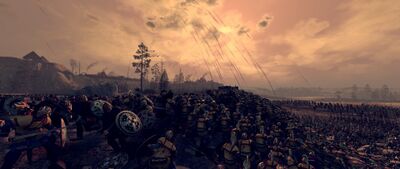Seleucus' Civil War
| Seleucus' Civil War | |||||||
|---|---|---|---|---|---|---|---|
 Symmerian and Seleucid troops in Quenmin | |||||||
| |||||||
| Belligerents | |||||||
| Seleucid Loyalists |
| ||||||
| Commanders and leaders | |||||||
|
Seleucus of Ioklos † Zeuxo Trịnh Hội |
Pratinas Melikertes Aeaces Borivoi | ||||||
| Units involved | |||||||
| Seleucid forces | Ancient Symmerian army | ||||||
| Strength | |||||||
| ~500,000-750,000 | ~1,000,000 | ||||||
| Casualties and losses | |||||||
| Near total | Heavy | ||||||
Seleucus' Civil War, also known as the Seleucid War or the Tân Dậu War, was fought between the forces loyal to Seleucus of Ioklos against the Symmerian Empire in eastern Siduri, in the years 1021-1038.
Seleucus, the son of nobility, was a strategos of the Ancient Symmerian army stationed in Quenmin. Quenmin, which had been heavily damaged during the Tống Rebellion and the Crisis of the Ninth Century. Widespread discontent with Symmerian rule left Quenmin and eastern Siduri in general in a constant state of unrest, with frequent rebellions and riots by discontent peasantry who often bore the cost of frequent conscription and heavy taxes. Seleucus realized open rebellion among the Quenminese was increasingly likely and began fermenting ties with Quenminese public figures and officials in order to stoke the fires of rebellion. It remains a matter of dispute between historians whether Seleucus was motivated by genuine sympathy for the plight of the Quenminese, or if he simply saw it as the best avenue for power. Regardless of his exact intentions, by 1020 Seleucus had gathered the support of most of the Quenminese Ten Ministries along with the assistance of several Symmerian officials and commanders in eastern Siduri, most noticeably Trịnh Hội.
Soldiers loyal to Seleucus seized control of the Viceroy's Chambers in Haigia, slaying Viceroy Theognis and his family in August 1021 to signify the start of the rebellion, after which Seleucus rapidly gained control of most of Quenmin. He then marched north in Serikos and conquered much of the countryside, aided by supporting Han revolts against Symmerian rule, though Seleucus himself would face opposition from some Serikese. A Symmerian army then invaded Quenmin from Shirvaniya, killing Seleucus' nephew Andriskos, but his army was reformed by his niece Zeuxo who defeated the Symmerians near Kontin. Seleucus reinforced his forces with levys from across eastern Siduri, while also hiring tens of thousands of mercenaries from the Rideva Empire, Eracira, Cacerta, and Lirinya.
While the Symmerians retreated westward Seleucus marched south in 1023 and absorbed the rest of Symmerian eastern holdings into his territory, but was defeated in Knichus and forced to leave half the country in Symmerian hands. Seleucus returned to Quenmin to fight an inconclusive campaign against the Symmerians under Melikertes in Tay Bien between 1024-1025, after which the Symmerians withdrew. Aeaces then led a Symmerian army into Serikos in 1026 and succeeded in recovering part of the coast, but was later defeat by Zeuxo, who pursued the Symmerians into Shrivaniya but was herself defeated and forced to withdraw back to Seleucid lands in 1027. Borivoi, a Galanian strategos, then invaded Serikos in the north and laid waste to many of the cities and ports along the way. He fought Zeuxo to a standstill in 1029, but remained in Serikos until 1031 when forced to withdraw to avoid fighting both Zeuxo and Seleucus.
Having mustered a massive army between 1030-1033, Pratinas invaded Quenmin, reaching Lairang before finally being defeated by three Seleucid armies under Seleucus, Zeuxo, and Trịnh Hội. Pratinas then marched south and sacked Buon Ma Thuot, before turning around and defeating Seleucus in Vũ Bá. Zeuxo was able to stalemate Pratinas before he could reach most of Hoang Thái, while Seleucus fled south then north into Nagarcam. Pratinas pursued him while Borivoi returned and managed to stop Zeuxo from rescuing Seleucus, who was forced to retreat towards My Xuyen. Borivoi followed Zeuxo north and fought a bloody battle at Coa Khoat, but was unable to defeat her and settled into a stalemate. Pratinas defeated Seleucus at My Xuyen, who then fled to Da Nang but was able to escape in 1035 after Pratinas laid siege to it.
Aeaces then invaded Serikos with a fresh army and defeated the Seleucids under Trịnh Hội, who was forced to flee south. He was subsequently defeated by Aeaces again at Cam Doc and was forced to abandon his forces and slip away as a civilian to avoid capture. Zeuxo fought Aeaces in Tuyên Hóa and initially won, but was defeated by the combined forces of Aeaces and Borivoi and fell back to Phan Thiet. Seleucus returned to Haiga to make his stand, which was besieged by the Symmerians in 1037. The Seleucids held out until 1038 but the city was eventually captured by the Symmerians; Seleucus perished in the fighting though his body was never recovered. Zeuxo surrendered at Bai Bien Ngao after a final defeat by Borivoi and was executed shortly afterwards, ending the war.
Seleucus' Civil War marked the beginning of the end for Symmerian control of Quenmin. Despite the defeat and reconquest by the Symmerians, the Quenminese population remained restless and rebellious strife continued in the years after. Trịnh Hội managed to escape and eluded efforts to find him; he later became a mentor to a young Hoạn Quốc Tổ, who would lead the Quenminese to victory in the Autumn Flag Rebellions 42 years later. Seleucus became a national hero in Quenmin and a symbol of connection between the Quenminese and Hellene immigrants.